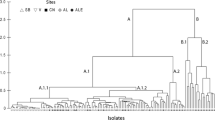Abstract
Means were sought to enhance the heat resistance of a strain of Rhizobium leguminosarum biovar phaseoli that died rapidly in soil at 43°C. Bacteria were more resistant to high temperatures in soil than broth or phosphate buffer. Starving the cells in phosphate buffer enhanced their heat resistance. Heat-resistant variants were obtained that grew at 45°C. Resistance of the parent culture to inactivation at 43°C was enhanced by immobilizing the cells in Ca alginate, amending the soil with clay or immobilization of the cells in clays. The bacteria survived better at 40°C in soil receiving montmorillonite-immobilized cells than in montmorillonite-amended soil. These results suggest that the tolerance of rhizobia to high temperatures in soils may be enhanced.
Similar content being viewed by others
References
Allen M B 1953 The thermophilic aerobic sporeforming bacteria. Bacteriol. Rev. 17, 125-173.
Bashan Y 1986 Alginate beads as synthetic inoculant carriers for slow release of bacteria that affect plant growth. Appl. Environ. Microbiol. 51, 1089-1098.
Bitton G, Henis Y and Lahav N 1976 Influence of clay minerals, humic acid and bacterial capsular polysaccharide on the survival of Klebsiella aeroqenesexposed to drying and heating in soils. Plant Soil 45, 65-74.
Bowen G D and Kennedy MM 1959 Effect of high soil temperatures on Rhizobiumspp. Queensl. J. Agric. Sci. 16, 177-197.
Chatel D L and Parker C A 1973 Survival of field-grown rhizobia over the dry summer period in Western Australia. Soil Biol. Biochem. 5, 415-423.
Day J M, Roughley R J, Eaglesham A R J, Dye M and White S P 1978 Effect of high soil temperatures on nodulation of cowpea, Vigna unguiculata. Ann. Appl. Biol. 88, 476-481.
Droffner M L and Yamamoto N 1985 Isolation of thermophilic mutants of Bacillus subtilisand Bacillus pumilusand transformation of the thermophilic trait to mesophilic strains. J. Gen. Microbiol. 131, 2789-2794.
Droffner M L and Yamamoto N 1991 Prolonged environmental stress via a two step process selects mutants of Escherichia, Salmonellaand Pseudomonasthat grow at 54 ºC. Arch. Microbiol. 156, 307- 311.
Gitonga N M, Widdowson D and Keya S O 1989 Interaction of Phaseolus vulgariswith thermotolerant isolates of Rhizobium leguminosarumbiovar phaseolifrom Kenyan soils. MIRCEN J. 5, 493-504.
Hansen N-H and Riemann H 1963 Factors affecting the heat resistance of nonsporing organisms. J. Appl. Bacteriol. 26, 314-333.
Hegde S V and Brahmaprakash G P 1992 A dry granular inoculant of Rhizobiumfor soil application. Plant Soil 144, 309-311.
Heijnen C E, Hok-A-Hin C H and Van Veen J A 1992 Improvements to the use of bentonite clay as a protective agent, increasing survival levels of bacteria introduced into soil. Soil Biol. Biochem. 24, 533-538.
Hoben H J and Somasegaran P 1982 Comparison of the pour, spread, and drop plate methods for enumeration of Rhizobiumspp. in inoculants made from presterilized peat. Appl. Environ. Microbiol. 44, 1246-1247.
Iswaran V, Sundara Rao W V B, Jauhri K S and Magu S P 1970 Effect of temperature on survival of Rhizobium japonicumin soil and peat. Mysore J. Agric. Sci. 4, 105-107.
Jouper-Jaan A, Goodman A E and Kjelleberg S 1992 Bacteria starved for prolonged periods develop increased protection against lethal temperatures. FEMS Microbiol. Ecol. 101, 229-236.
Karanja N K and Wood M 1988Selecting Rhizobium phaseolistrains for use with beans (Phaseolus vulgarisL.) in Kenya: tolerance of high temperature and antibiotic resistance. Plant Soil 112, 15-22.
Marshall K C 1964 Survival of root-nodule bacteria in dry soils exposed to high temperatures. Aust. J. Agric. Res. 15, 273-281.
Oliver J 1966Soil temperatures in the arid tropics, with reference to Khartoum. J. Trop. Geogr. 23, 47-54.
Smidsrød O and Skjåk-Braek G 1990 Alginate as immobilization matrix for cells. Trends Biotechnol. 8, 71-78.
Strange R E and Shon M 1964 Effects of thermal stress on viability and ribonucleic acid of Aerobactor aerogenesin aqueous suspension. J. Gen. Microbiol. 34, 99-114.
Vincent J M 1970 A Manual for the Practical Study of Root-Nodule Bacteria. Blackwell Scientific Publications, Ltd., Oxford.
Wilkins J 1967 The effects of high temperatures on certain root-nodule bacteria. Aust. J. Agric. Res. 18, 299-304.
Wise J A 1991 A procedure for the effective recalibration of liquid-in-glass thermometers. Natl. Inst. Stand. Technol. Spec. Publ. 819. US Government Printing Office, Washington, DC.
Author information
Authors and Affiliations
Rights and permissions
About this article
Cite this article
AbdelGadir, A., Alexander, M. Procedures to enhance heat resistance of Rhizobium. Plant and Soil 188, 93–100 (1997). https://doi.org/10.1023/A:1004200329070
Issue Date:
DOI: https://doi.org/10.1023/A:1004200329070




